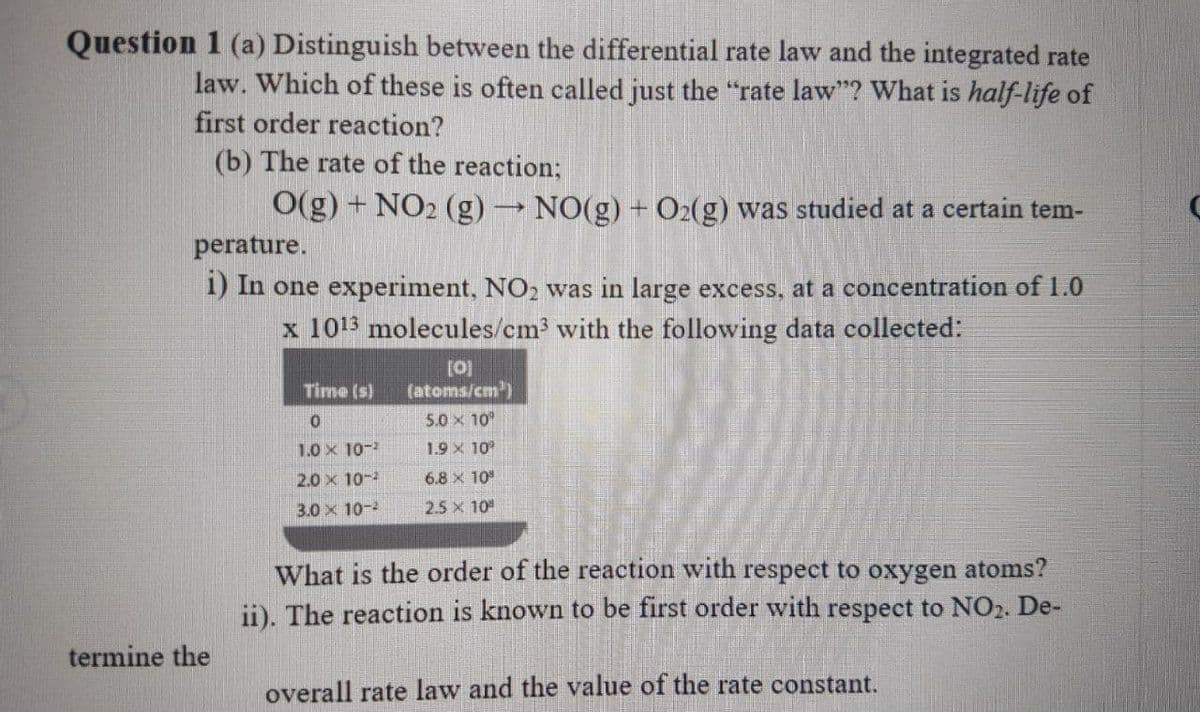Question 1 (a) Distinguish between the differential rate law and the integrated rate law. Which of these is often called just the "rate law"? What is half-life of first order reaction? (b) The rate of the reaction; O(g) + NO2 (g) → NO(g) + O2(g) was studied at a certain tem- perature. 1) In one experiment, NO, was in large excess, at a concentration of 1.0 x 1013 molecules/cm with the following data collected: Time (s) (atoms/cm) 5.0 x 10 1.0 x 10-2 1.9 X 10 2.0 x 10- 6.8 x 10 3.0 x 10-2 2.5 x 10 What is the order of the reaction with respect to oxygen atoms? ii). The reaction is known to be first order with respect to NO2. De- termine the overall rate law and the value of the rate constant.
Question 1 (a) Distinguish between the differential rate law and the integrated rate law. Which of these is often called just the "rate law"? What is half-life of first order reaction? (b) The rate of the reaction; O(g) + NO2 (g) → NO(g) + O2(g) was studied at a certain tem- perature. 1) In one experiment, NO, was in large excess, at a concentration of 1.0 x 1013 molecules/cm with the following data collected: Time (s) (atoms/cm) 5.0 x 10 1.0 x 10-2 1.9 X 10 2.0 x 10- 6.8 x 10 3.0 x 10-2 2.5 x 10 What is the order of the reaction with respect to oxygen atoms? ii). The reaction is known to be first order with respect to NO2. De- termine the overall rate law and the value of the rate constant.
Chemistry: The Molecular Science
5th Edition
ISBN:9781285199047
Author:John W. Moore, Conrad L. Stanitski
Publisher:John W. Moore, Conrad L. Stanitski
Chapter11: Chemical Kinetics: Rates Of Reactions
Section: Chapter Questions
Problem 113QRT
Related questions
Question

Transcribed Image Text:Question 1 (a) Distinguish between the differential rate law and the integrated rate
law. Which of these is often called just the "rate law"? What is half-life of
first order reaction?
(b) The rate of the reaction;
O(g) + NO2 (g) → NO(g) + O2(g) was studied at a certain tem-
perature.
1) In one experiment, NO2 was in large excess, at a concentration of 1.0
x 1013 molecules/cm3 with the following data collected:
Time (s)
(atoms/cm)
5.0 x 10
1.0x 10-
1.9 X 10
2.0 x 10-
6.8 x 10
3.0 x 10-
2.5 x 10
What is the order of the reaction with respect to oxygen atoms?
ii). The reaction is known to be first order with respect to NO2. De-
termine the
overall rate law and the value of the rate constant.
Expert Solution
This question has been solved!
Explore an expertly crafted, step-by-step solution for a thorough understanding of key concepts.
This is a popular solution!
Trending now
This is a popular solution!
Step by step
Solved in 2 steps with 2 images

Knowledge Booster
Learn more about
Need a deep-dive on the concept behind this application? Look no further. Learn more about this topic, chemistry and related others by exploring similar questions and additional content below.Recommended textbooks for you

Chemistry: The Molecular Science
Chemistry
ISBN:
9781285199047
Author:
John W. Moore, Conrad L. Stanitski
Publisher:
Cengage Learning


Chemistry
Chemistry
ISBN:
9781305957404
Author:
Steven S. Zumdahl, Susan A. Zumdahl, Donald J. DeCoste
Publisher:
Cengage Learning

Chemistry: The Molecular Science
Chemistry
ISBN:
9781285199047
Author:
John W. Moore, Conrad L. Stanitski
Publisher:
Cengage Learning


Chemistry
Chemistry
ISBN:
9781305957404
Author:
Steven S. Zumdahl, Susan A. Zumdahl, Donald J. DeCoste
Publisher:
Cengage Learning


Chemistry: An Atoms First Approach
Chemistry
ISBN:
9781305079243
Author:
Steven S. Zumdahl, Susan A. Zumdahl
Publisher:
Cengage Learning

Chemistry for Engineering Students
Chemistry
ISBN:
9781337398909
Author:
Lawrence S. Brown, Tom Holme
Publisher:
Cengage Learning